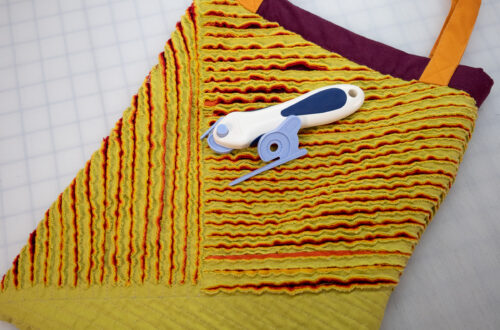Freehand Yarn Embroidery on Felt (QUOE TIPS)

I don’t know what it is about felt berets, but I constantly find myself drawn to them as a canvas for whatever fibery rabbit hole I’m heading down at the time.
Maybe it has to do with the fact I totally see myself wearing one as a chic Parisian walking down Champs-Elysées with a coffee in hand, or maybe its the fact that wool felt is a perfect blank slate for so many of my projects. The world will never know.
So what happens when you take some leftover sock yarn and try embroidering with it onto said beret? Lets find out!
Supplies:
- Thread Clipper “Kuroha”- Art No. 415
- Sashiko Needles (Long) – Art. No 2009
- Yarn Threader – Art. No 3142
- Misc. Fingering Weight Yarn
- Wool Felt Beret or Felt Sheets


Setup: To begin, snip an approximately 3-foot long length from your desired yarn. This is the length you should cut every time you need additional yarn. Take the yarn threader, and pass it through the eye of the largest sashiko needle.Now, take an end of your prepared yarn and pass it through the tip of the yarn threader eye for a couple inches. Finally, pull the yarn through by removing the yarn threader from the needle eye. Match up the ends of yarn, secure with an overhand knot, and snip off the excess.


Begin Embroidery: To begin embroidery, first think of a general shape you would like to map out and keep it in mind. Being freehand, there will be no template or traced lines to follow. Perfect stitches or shapes are not what you are after, rather it is to spark creativity, and doodle with your own medium. Pass the needle through the back of the work at your starting point, we will start by outlining the shape. Pull the yarn through to about one inch from the bottom knot. Pass the yarn through your work from the front of the work right beside the previous point and in between the two strands of yarn from the inch at the back of the work. Pull tight to secure.


Outlining: In this example, I will first make a triangle on a felt sheet. To outline, backstitch around the general shape of your desired icon. Be sure you fill every space, and that there is no line breaks around the outline. Again, this is not about perfect lines, let yourself have some fun! If you encounter a problem stitch or find that a line is crooked you can go back and fix it while filling the inner stitches in.



Filling It In: To fill in large areas within the outline, use a tightly condensed seed stitch, also known as a rice stitch. stitches made can be sporadic and in any direction. Start from wherever the ending stitch of the outline is, and move towards the opposite side of the icon, filling in as you see fit. Stop using yarn once you have about four inches left. If additional yarn is required, refer to finishing directions below to end current thread, then join the yarn as setup and continue until icon is filled.


Finishing: Pass needle to back of work. Once there, pass needle through the yarn on the back of work, burying the working yarn into the back stitches. Pull taught, then repeat the process in the opposite direction. Snip end.


Beyond The Basics: Take a step back and consider what your shape reminds you of, and if you would like to work on it further. My triangle gave me a watermelon vibe, so using the steps above, I joined green and white yarns for a rind, and black aptly named seed stitches for seeds.



Joining: If you have embroidered directly onto the beret, this step won’t be necessary. If working from a felt sheet, cut around embroidery leaving about a centimeter of fabric around the icon. Place piece in desired section of beret, then whipstitch around to secure using above steps of joining and finishing.



Follow what Quayln is up to next on his Blog | Instagram | Facebook | Pinterest | YouTube | Ravelry
Stay connected with Clover on Facebook | Twitter | Instagram | Pinterest | YouTube | Ravelry


